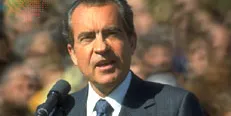Richard M. Nixon’s Visit to Moscow and Its Aftermath
Richard Milhous Nixon, the 37th President of the United States, made significant strides in foreign policy, particularly in improving relations with the Soviet Union. His historic visit to Moscow in May 1972 marked a pivotal moment in Cold War history, initiating a period of détente between the two superpowers. This visit not only showcased Nixon’s adeptness in diplomacy but also had profound and lasting impacts on international relations and domestic policies in the years that followed.
The Context of Nixon’s Visit
The early 1970s were a time of intense geopolitical tension. The Cold War, characterized by the ideological and military rivalry between the United States and the Soviet Union, dominated global affairs. By the time Nixon took office in 1969, the Vietnam War had escalated, and there were ongoing nuclear arms races and numerous proxy conflicts around the world.
Nixon, along with his National Security Advisor Henry Kissinger, sought to ease these tensions through a policy of détente, aiming to reduce the risk of nuclear conflict and create a more stable international environment. Key to this strategy was improving relations with the Soviet Union and the People’s Republic of China, both of which Nixon pursued aggressively.
The Moscow Summit of 1972
Nixon’s visit to Moscow in May 1972 was a carefully planned diplomatic mission. He met with Soviet Premier Leonid Brezhnev, Chairman Alexei Kosygin, and Foreign Minister Andrei Gromyko. The summit yielded several critical agreements, most notably the Strategic Arms Limitation Talks (SALT I) and the Anti-Ballistic Missile Treaty (ABM Treaty).
SALT I Agreement: This landmark treaty was the first to limit the number of intercontinental ballistic missiles (ICBMs) and submarine-launched ballistic missiles (SLBMs) possessed by the two superpowers. While it did not reduce existing arsenals, it capped the number of these weapons and marked a significant step towards controlling the nuclear arms race.
ABM Treaty: This agreement restricted the development and deployment of anti-ballistic missile systems, which were designed to defend against nuclear attacks. By limiting these systems, both nations acknowledged the destabilizing potential of such defenses and aimed to preserve the doctrine of mutually assured destruction (MAD), which held that the prospect of total mutual annihilation would deter either side from launching a first strike.
The Aftermath and Long-Term Impact
Nixon’s visit to Moscow and the resulting agreements had several immediate and far-reaching effects:
Détente: The successful negotiation of SALT I and the ABM Treaty symbolized the onset of détente, a thawing of Cold War hostilities. This period saw increased diplomatic and economic interactions between the East and West, including cultural exchanges and trade agreements. The Helsinki Accords of 1975, which further advanced cooperation and security in Europe, were a direct outgrowth of this improved atmosphere.
Domestic Political Impact: For Nixon, the Moscow summit was
a significant political victory. It bolstered his image as a statesman capable of achieving peace and enhanced his re-election campaign in 1972. Despite the domestic turmoil of the Vietnam War and rising anti-war sentiment, the successful diplomatic engagement with the Soviet Union demonstrated his ability to navigate complex international issues.
Soviet-American Relations: The summit marked a new era in Soviet-American relations. The agreements established a framework for ongoing negotiations and cooperation. Although détente would experience setbacks, particularly during the late 1970s with the Soviet invasion of Afghanistan, the groundwork laid by Nixon and Brezhnev facilitated future arms control negotiations, including SALT II and the eventual START treaties.
Strategic Stability: The SALT I and ABM Treaty helped to stabilize the strategic balance between the United States and the Soviet Union. By limiting missile systems and anti-ballistic defenses, the agreements curbed the arms race and reduced the likelihood of a nuclear confrontation. This strategic stability allowed both nations to redirect resources from military expenditures to domestic needs, albeit unevenly.
Global Perceptions: Nixon’s visit and the subsequent détente also had global ramifications. It reassured U.S. allies in Europe and Asia of America’s commitment to peace and stability, while simultaneously signaling to other countries the possibility of easing Cold War tensions. For the non-aligned movement and countries in the developing world, it suggested that superpower rivalries might not inevitably lead to global conflict.
Challenges and Criticisms
Despite the successes, Nixon’s visit to Moscow and the détente policy were not without criticisms and challenges:
Continued Rivalry: While the treaties capped certain types of weapons, they did not eliminate the deep-seated ideological and strategic rivalry between the U.S. and the Soviet Union. Both nations continued to support opposing sides in regional conflicts, such as in the Middle East and Africa.
Verification Issues: The limitations imposed by the SALT I agreement and the ABM Treaty required rigorous verification mechanisms. Ensuring compliance proved to be complex and often contentious, with each side accusing the other of violations or seeking ways to circumvent the terms of the agreements.
Domestic Opposition: In the United States, some critics argued that Nixon’s approach to the Soviet Union was too conciliatory and feared it might embolden Soviet aggression. Conversely, others believed the agreements did not go far enough in reducing the nuclear threat and called for more substantial arms reductions.
Legacy
Richard Nixon’s visit to Moscow in 1972 was a landmark event that reshaped the landscape of international relations during the Cold War. It demonstrated the potential for diplomacy to achieve strategic stability and paved the way for future arms control agreements. While the era of détente faced numerous challenges and was ultimately limited in scope, the principles and frameworks established during Nixon’s presidency had a lasting impact on how the superpowers managed their relationship and navigated the complexities of global politics. Nixon’s Moscow visit remains a testament to the power of engagement and negotiation in the pursuit of peace and security.
newshub











Recent Comments